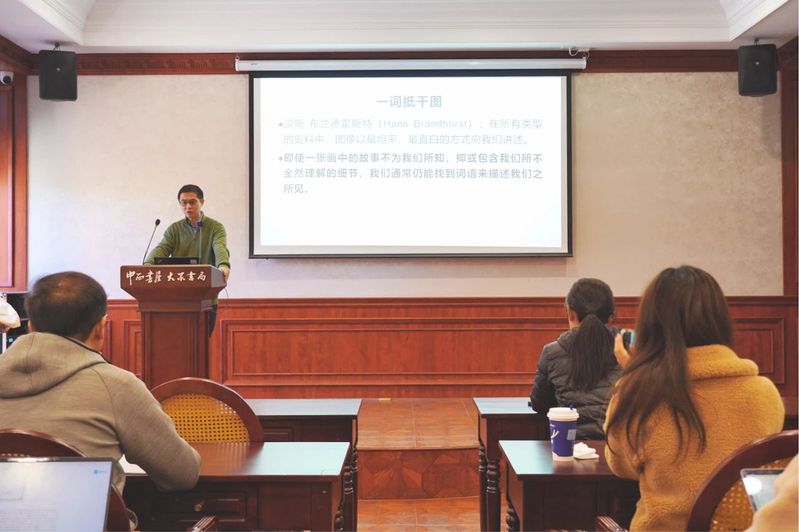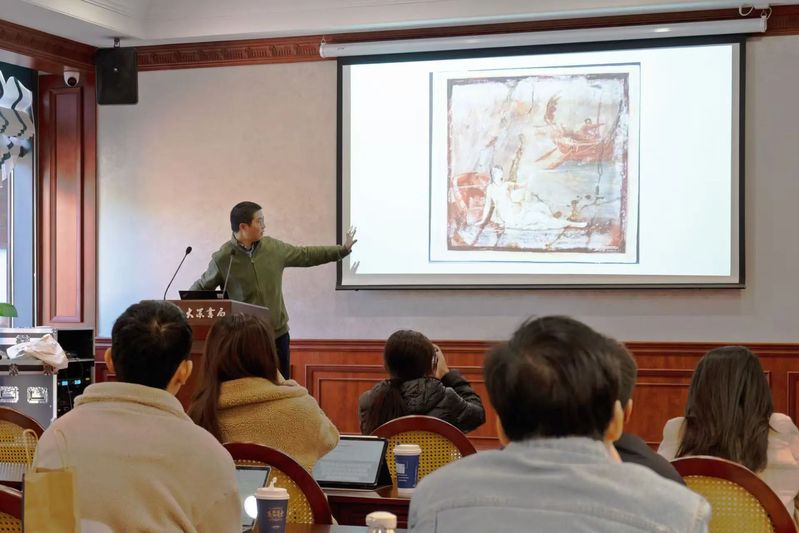Recently, the 15th session of the Qizhen Qiushi Media Circle lecture series, jointly organized by the Digital Communication Research Center of Zhejiang University, the College of Media and International Culture, the Institute of Aesthetics and Critical Theory, and the Zhejiang University Convergence Research Program for Digital Social Science, was held at the Zhongxi Study Room, Dazhong Bookstore (Zhejiang University campus bookstore). The lecture featured Professor Han Weihua from the School of Government at Nanjing University as the keynote speaker and was hosted by Professor Fan Yun.

Theories and Perspectives in Iconology
Han Weihua delivered a lecture titled Images as Media: The Hidden Dialogue Between Intellectual History and Art History, sharing his interdisciplinary research findings on the political intellectual history and art history. He also introduced portions of his forthcoming book, The Politics of Images: European Civilization in Art History.
The lecture was divided into two parts. The first part provided an introduction and discussion of key theoretical perspectives from prominent iconologists. The second part interpreted the rich meanings of historical images in contemporary contexts through the analysis of masterpieces in art history.

Han began by introducing the contributions of influential figures in image studies, such as Johann Joachim Winckelmann, Aby Warburg, Erwin Panofsky, and Jaś Elsner, exploring their theories from the perspective of prior to text. For instance, he discussed Winckelmann's metaphor in The History of Ancient Art, likening the fate of artworks to lovers by the seashore—emphasizing longing for the lost and intense focus on reproductions. Han reflected on his own academic experience, where he could only access photocopies of texts instead of original English editions, which deepened his appreciation for the material at hand. He highlighted how Winckelmann's studies of Roman copies emphasized the challenges posed by incomplete relics and the importance of imagination in historical reconstruction—a central theme that remains relevant today.
Han went on to discuss Jaś Elsner’s analysis of the relationship between image and text in Art History in the Context of Global Turn. Elsner's perspective on the coexistence of rationality and idealism in academic research was highlighted as a critical factor in achieving originality in studies. Drawing on Aby Warburg's work, Han emphasized Warburg's unique research approach, which valued creative connections and broke normative boundaries. He delved into Warburg's unfinished project, Mnemosyne Atlas, which involved rearranging and expanding thematic panels to explore relationships between images and between history and reality.
Han also introduced Panofsky's iconology theory, explaining its three levels of analysis: pre-iconographic description, iconographic analysis in the narrow sense, and iconological interpretation at a deeper level. Panofsky's later refinements of this theory in 1955 further expanded its scope. Han concluded that the originality of thinkers like Warburg and Panofsky lies in their continuous refinement and reconstruction of their methodologies rather than establishing fixed frameworks.
Case Studies in Images
In the second part, Han presented a variety of images, ranging from sculptures of Ramses II to the Egyptian exhibition at the Shanghai Museum, graffiti-covered statues of Amenhotep III, and James Stephanoff's watercolor series Art Collections from the Beginning of the World to the Time of Phidias. He analyzed The Age of Augustus: The Birth of Jesus Christ at the Musée d'Orsay, linking it to Warburg’s Mnemosyne Atlas and exploring the political background of the reconciliation between the Roman Church and the Italian Kingdom. Han also discussed the reconstruction of the Ara Pacis by Mussolini, comparing it to the Palazzo Vecchio in Florence and the U.S. Capitol dome, as well as the United Nations Security Council mural and the restored School of Athens tapestry in the French National Assembly. Through these examples, he emphasized the dialogue between history and reality in art, the replication and dissemination of artworks over time, and the critical role of temporality in art interpretation.
Han also explored the relationship between cartoons and political events, analyzing satirical cartoons targeting Louis XVI and 19th-century French politicians, as well as recent covers of The Economist featuring caricatures of Donald Trump and Elon Musk. Quoting W.J.T. Mitchell’s Picture Theory, Han noted, “Ever since the invention of mechanically reproducible images, every politician's face has been subject to public ridicule. Yet Trump poses a new challenge in cartoon history: he seems impervious to caricature, as he himself is a caricature and a master of the genre.” Han emphasized that this phenomenon is not merely political but a broader cultural phenomenon, reflecting the evolving role of satire in global media.
Reflections on Iconology and Visual Texts

In his conclusion, Han pointed out that since Warburg and Panofsky laid the foundation for iconology, the value of images has garnered increasing scholarly attention. Although intellectual historians and art historians employ different methodologies, surviving images provide unique insights into the past and inspire historical reconstruction. Today, images are no longer seen merely as supplementary to textual materials but as visual texts in their own right, embodying the spirit of their time. By integrating images and texts, new perspectives can emerge for reinterpreting history.

